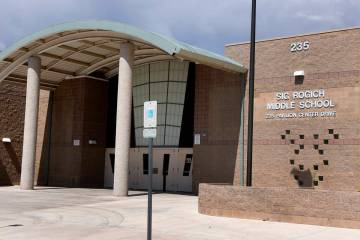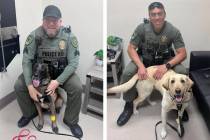First year of Nevada scholarship shows promise
Christina Martinez-Luna has some advice for Nevada’s current high school seniors: apply early for Promise, the state’s newest scholarship program.
“Apply as soon as possible, because it’s really beneficial,” Martinez-Luna said.
She’s one of 452 College of Southern Nevada freshman who received a scholarship in the first year of the program, which covers student fees at a community college after other aid sources have been exhausted.
Her $1,200 fall semester award filled in the financial gaps that remained, and she’s now pursuing her nursing degree with the ultimate goal of becoming a pediatrician.
“It’s feels relieving that you don’t have to pay that much money,” she said.
While a few hundred more students are seeing the benefits of the program for the first time this fall, the cohort is a tiny fraction of the more than 9,000 high school seniors who applied for the scholarship at CSN. Preliminary numbers show that only $1.8 million of the $3.5 million state allocation has been used.
Higher education officials are reviewing what worked and what may need tweaking as Promise moves into its second year.
Changing the landscape
The program is modeled after Tennessee Promise, the nation’s first statewide “free community college” program.
Promise applicants in Nevada must attend two training sessions, complete the Free Application for Student Aid, meet with a mentor and complete 20 hours of community service in order to remain eligible.
But officials in Nevada and Tennessee say it’s about much more than giving money to students.
“It is about creating a college-going culture and a student success program,” said Maria Marinch, executive director of inclusive learning and engagement at CSN.
James Snider, director of the Tennessee Promise Scholarship, said the program is improving his state.
“So many people look at this only as a financial aid benefit,” Snider said. “But as we educate our youth, we change our workforce. The more educated the workforce, the more employable we are. Every student in a high school in Tennessee has this opportunity if they choose to take it.”
Tennessee’s program is also part of Gov. Bill Haslam’s “Drive to 55” initiative, which is challenging the state equip 55 percent of its residents with a post-secondary credential by 2025. The attainment rate is nearly 41 percent.
Tennessee has also made strides in FAFSA filings, and has led the nation in this venture for the past four years.
Like Nevada, Tennessee recognized early on that getting students to apply for the FAFSA can be a barrier.
“We’ve doubled down the efforts of FAFSA completion,” Snider said, adding that students leave money on the table if they don’t fill it out. “FAFSA completion is an indicator for future matriculation. It’s opening the door to that potential of federal and state financial aid.”
Creating a vision
Even without Promise, many students from low-income backgrounds can attend college at no cost to them through the federal Pell grant. At CSN, 226 students who applied for Promise and completed all of the steps are enrolled in classes, but did not need the scholarship because other financial aid dollars met their need.
“It’s about getting the message across that everyone can take advantage of this,” said Nate Mackinnon, vice chancellor for community colleges at the Nevada System of Higher Education. “The notion that college is too expensive will some day not be an issue for high school seniors.”
Promise scholarship awards ranged from $20 to $1,959 for the fall semester.
Entering year two of the program, community college officials are ramping up the communication with school districts across the state, and created priority deadlines to encourage high school seniors to apply for the FAFSA by the end of the calendar year, and not the April 30, 2019, deadline. Mackinnon said this eases the pressure in the event that a student is selected for verification.
CSN officials have also slightly changed the application process. They’re asking students to share the field of study that they might be interested in at the point of application. Later, they might be paired with a mentor who is also working in that field, Marinch said.
“We help them get the information they need to develop a vision of where they want to be, and how they need to get there,” Marinch said.
Anecdotal student stories also revealed potential issues with the community service requirement, with Margo Martin, interim vice president of transition activities at CSN, reporting transportation challenges, and students who had difficulty balancing work, school and family commitments.
Marinch said they’re talking to partners like local municipalities and the United Way of Southern Nevada to organize community service events and coordinating with the Clark County School District to provide community service opportunities at high schools.
In addition, Mackinnon said he’s spoken with researchers about the potential of conducting a qualitative review to determine why a student might have applied, but didn’t finish all of the steps.
“Overall, we feel really great about this program and the success it’s had in year one,” Mackinnon said. “We didn’t know setting out a year ago when we made the application live if 100, 1,000 or 10,000 students would apply. We now need to translate that into more enrolled students.”
Contact Natalie Bruzda at nbruzda@reviewjournal.com or 702-477-3897. Follow @NatalieBruzda on Twitter.




























